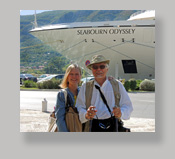 
VENICE | CROATIA | MONTENEGRO | CORFU | KAFALONIA | PYLOS | NAFPLION | PIRAEUS | MILOS | MYKONOS PATMOS | KUSADASI | CHIOS | ISTANBUL DAY 1 | ISTANBUL DAY 2 | ISTANBUL DAY 3 | TRAVEL REFLECTIONS |
 
VENICE | CROATIA | MONTENEGRO | CORFU | KAFALONIA | PYLOS | NAFPLION | PIRAEUS | MILOS | MYKONOS PATMOS | KUSADASI | CHIOS | ISTANBUL DAY 1 | ISTANBUL DAY 2 | ISTANBUL DAY 3 | TRAVEL REFLECTIONS |
CROATIA: Sibenik, Trogir and Split, 9-23-12
After leaving Venice yesterday, we cruised overnight and arrived at our first port-of-call, Sibenik, on a bright and beautiful Sunday morning. The ship had to thread its way thru a windy, narrow strait at the end of which is a harbor, one of the most protected in the Adriatic, with the town on Sibenik on its shores. The ship is too big to dock and so we took a tender to shore to meet our guides for the day. We decided to see two towns along the Dalmatian Coast. Our guide was a young Croatian woman who spoke excellent English. Here are just a couple of things she told us: 1. What in the US we call speed bumps in Croatia are called "sleeping policemen". 2. She had a story about olive trees and grape vines. Olive trees, Croatians say, are like a mother: even if they are ignored for a long time, when you come back you are welcomed with generosity and abundance. Vinyards, however, are like a wife: they required constant and meticulous care.
The trip to Split, the second city, continued our drive along the picturesque Dalmatian Coast. The history of Split starts with the Roman Emperor Diocletian who, among other things, is notable for being the first Roman Emperor to |